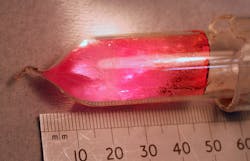The 1953 invention of the maser predated that of the laser and was the first demonstration of stimulated emission of electromagnetic radiation. Now, masers serve as frequency standards for atomic clocks and as components of radio telescopes. But existing masers are expensive and finicky things, requiring powerful magnets, vacuum chambers, or cryogenic cooling.
A new type of solid-state maser developed by scientists at the National Physical Laboratory (Teddington, England) and Imperial College (London, England) requires none of these, consisting simply of a pentacene-doped crystal of p-terphenyl (an aromatic hydrocarbon) pumped by yellow light from a pulsed dye laser.1
The pentacene dopant turns the pterphenyl crystal bright pink (see figure); the finished crystal is cut into a rod shape, polished, and set within a cylindrical sapphire ring. The room-temperature maser amplifies in the 1.45 GHz region and, when configured as an oscillator, has a microwave output of -10 decibel milliwatts (dBm), which is a factor of 108 higher than that of a conventional atomic-hydrogen maser emitting at 1.42 GHz.
Narrow linewidth
The dye laser produces 0.5 J pulses at a 585 nm wavelength; about 0.3 J per pulse is absorbed by the maser crystal. The sapphire resonator, which was modeled using multiphysics-modeling software by COMSOL (Burlington, MA), supports a frequency-tunable transverse-electric TE01d mode that has a mode volume of about 50 cm3 and resonates at an unloaded quality (Q) factor of about 2 × 105.
The pump laser provides pulses of about 0.4 ms duration; the resulting maser pulses, which very quickly reach their maximum power, are about the same duration. By attenuating the yellow pump beam with neutral-density filters, the researchers determined the threshold pump energy to be 80 mJ, which corresponds to a 230 W threshold pump power.
The 6 kHz linewidth of the maser output was consistent with that of a sine wave modulated by the maser’s pulse envelope—in other words, the maser’s linewidth is as narrow as it can theoretically get. With the resonator kept in tune, the maser pulses did not change in size or shape, even after 1000 pump pulses.
Laser-like configuration
One important feature of the new maser is its low noise when used as an amplifier. Currently, conventional masers cryogenically cooled to below 10 K and operated under a strong magnetic field are used as low-noise microwave amplifiers, for example, in deep-space communications. To be useful in such applications, the new maser would have to show low-noise operation; measurements show that it does indeed have a low noise temperature below 140 mK.
The team believes that by improving the crystal quality and the optical pumping, as well as the quality of the resonator, the maser’s threshold power and noise temperature can be reduced. The researchers are interested in creating a similar maser that has a continuous-wave output, which would require precise balancing of various parameters such as spin-lattice and spin-spin relaxation times. They also want to get the maser to operate over a range of microwave frequencies instead of its current narrow bandwidth.
Other goals include the identification of different materials that can emit at room temperature while consuming less power than pentacene-doped pterphenyl, and the creation of new designs that could make the maser smaller and more portable.
The researchers note that the maser’s ability to operate under ambient conditions and under the earth’s low ambient magnetic field, and at the same time either as an oscillator or amplifier with very low noise, could make it useful for sensitive medical scanning instruments, improved chemical sensors for remotely detecting explosives, lower-noise readout mechanisms for quantum computers, and sensitive radio telescopes for potentially detecting life on other planets.
REFERENCE
1. M. Oxborrow et al., Nature, 488, 353 (Aug. 16, 2012).

John Wallace | Senior Technical Editor (1998-2022)
John Wallace was with Laser Focus World for nearly 25 years, retiring in late June 2022. He obtained a bachelor's degree in mechanical engineering and physics at Rutgers University and a master's in optical engineering at the University of Rochester. Before becoming an editor, John worked as an engineer at RCA, Exxon, Eastman Kodak, and GCA Corporation.
